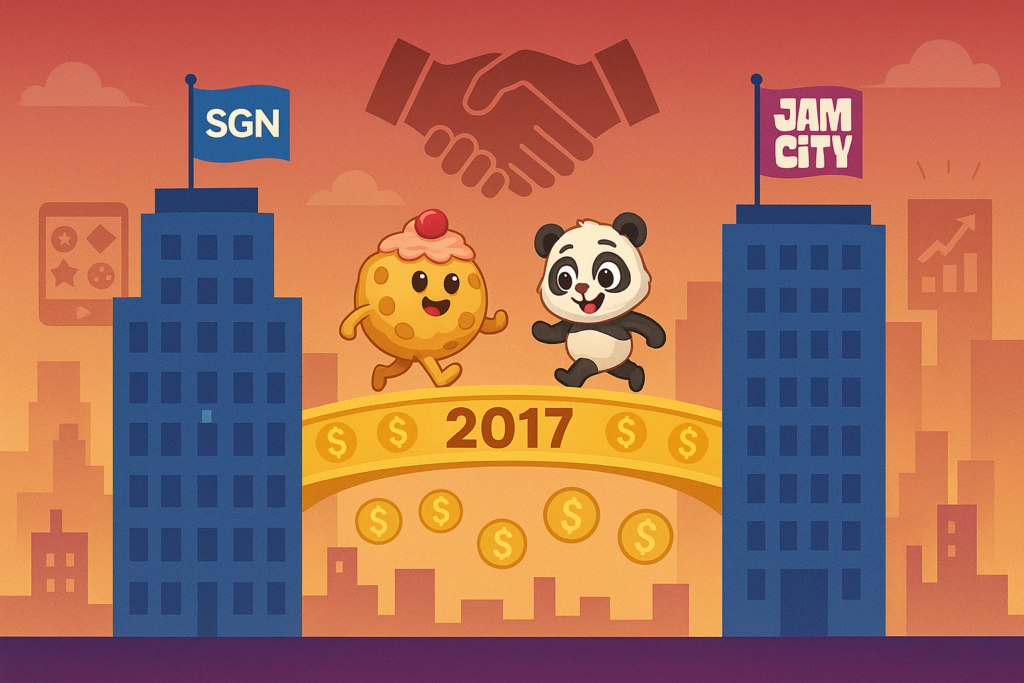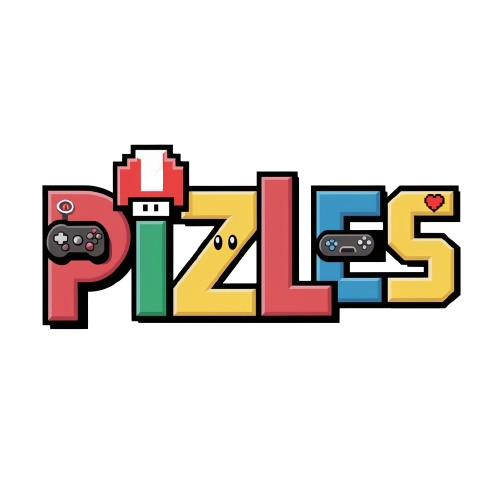SGN Games Inc transformed into Jam City in September 2016, marking one of mobile gaming’s most successful rebrands. Founded in 2010 by MySpace co-founder Chris DeWolfe with Josh Yguado, Colin Digiaro, and Aber Whitcomb, the company has grown to more than 825 employees and become a mobile gaming powerhouse.
The SGN Games Era: Building the Foundation (2010-2016)
Origins and Early Strategy
SGN, which stands for Social Gaming Network, was a name that DeWolfe inherited through an acquisition he made in 2011 from venture capitalist Shervin Pishevar, co-founder of start-up Hyperloop One. The company began as a strategic consolidation of mobile gaming assets during the early smartphone boom.
Key Milestones During SGN Period
- 2010: Company founded with backing from Austin Ventures
- 2011: Acquired Social Gaming Network name and assets
- 2012-2015: Developed core match-3 gaming expertise
- 2016: Reached critical mass for major rebrand
The Transformation: Why SGN Became Jam City

Strategic Reasons Behind the Rebrand
SGN rebranded as Jam City in September 2016, the same year Genies & Gems, a match-3 puzzle game, was launched. The rebrand represented more than just a name change – it signaled a new era of mobile gaming focus.
Brand Evolution Benefits
- Fresh identity for expanding mobile gaming market
- Enhanced brand recognition beyond casual gaming
- Strategic positioning for premium IP partnerships
- Improved market differentiation from competitors
Jam City’s Game Portfolio: The Hits That Define Success
Cookie Jam: The Billion-Dollar Success
Cookie Jam has generated over $1 billion in aggregate lifetime bookings, making it one of the most successful match-3 mobile games ever created. The game’s success validated Jam City’s casual gaming strategy.
Harry Potter: Hogwarts Mystery Breakthrough
It was the fastest of Jam City’s games to reach $100 million in revenue, generating $110 million in its first year. By October 2019, it had been downloaded 54.6 million times. The game proved Jam City’s ability to handle premium IP licensing.
Panda Pop: Long-Term Success
Panda Pop has been downloaded more than 140 million times, demonstrating consistent player engagement and monetization success across multiple years.
Financial Growth: From Startup to Gaming Giant
Revenue Trajectory
DeWolfe added that Jam City revenues have grown by 100% every year for the last five years. He said he expects revenues to surpass $400 million within the coming year. This explosive growth pattern positioned Jam City as a major mobile gaming publisher.
Investment and Backing
Since receiving $130 million from Netmarble Games last year in what was the largest investment in a privately held gaming studio, Jam City secured significant funding for continued expansion.
Current Game Portfolio: What Jam City Offers in 2025
Flagship Titles
Jam City is the creative powerhouse behind some of the highest-grossing and most enduring mobile games including Harry Potter: Hogwarts Mystery, Cookie Jam and Panda Pop.
Development Strategy
Jam City develops immersive, narrative rich mobile games based on original IP and in partnership with leading entertainment brands, focusing on both original content and licensed properties.
Popular Games List
- Cookie Jam – Match-3 puzzle game
- Harry Potter: Hogwarts Mystery – RPG adventure
- Panda Pop – Bubble shooter
- Disney Emoji Blitz – Character collection game
- Genies & Gems – Match-3 puzzle game
Technology and Innovation: AI-Driven Gaming
Player Experience Focus
Jam City leverages AI to always improve the player experience. Every Jam City user plays our games a little bit differently, allowing for personalized gaming experiences.
Monetization Technology
That time is really maximized and could theoretically be a 50-100% to 2x increase in overall ad revenue, showing how Jam City optimizes revenue through advanced ad placement technology.
Strategic Partnerships and IP Licensing
Premium Brand Collaborations
- Harry Potter – Warner Bros. partnership
- Disney – Multiple IP collaborations
- Peanuts – Character licensing deals
- Care Bears – Cross-promotional content
Partnership Strategy Benefits
- Higher revenue per user through premium content
- Enhanced brand recognition via established franchises
- Reduced marketing costs through built-in audiences
- Long-term player retention via beloved characters
Market Position: Jam City vs. Competitors in 2025
Competitive Advantages
- Proven IP management with billion-dollar franchises
- Diverse game portfolio across multiple genres
- Strong monetization through freemium models
- Global reach with localized content
Industry Standing
The company has five of the top 100 highest-grossing games in the app stores. Its games have been downloaded more than 800 million times, establishing Jam City as a top-tier mobile publisher.
Key Success Factors: What Made the Transformation Work
Leadership Vision
Chris DeWolfe’s experience from MySpace’s social media success translated effectively to mobile gaming’s social and engagement mechanics.
Strategic Acquisitions
- MindJolt (2010) – Gaming technology
- SGN brand (2011) – Market presence
- TinyCo (2016) – IP and development talent
Market Timing
The 2016 rebrand coincided with:
- Smartphone market maturation
- Freemium model optimization
- Premium IP licensing opportunities
- Advanced mobile monetization techniques
Challenges and Lessons Learned
Industry Challenges Overcome
- High user acquisition costs in competitive mobile market
- App store algorithm changes affecting game discovery
- Player retention in saturated casual gaming market
- IP licensing complexity for premium brands
Strategic Solutions
- AI-driven personalization for improved retention
- Cross-game promotion within Jam City portfolio
- Live operations excellence for ongoing engagement
- Data-driven development for optimal game design
Future Outlook: What’s Next for Jam City in 2025
Growth Opportunities
- Emerging markets expansion
- New IP partnerships with streaming platforms
- Cross-platform gaming development
- Web3 and NFT integration possibilities
Technology Trends
- Enhanced AI personalization
- Cloud gaming integration
- Augmented reality features
- Social gaming evolution
Conclusion: A Transformation Success Story
The SGN Games to Jam City transformation represents one of mobile gaming’s most successful rebrands. From a startup consolidating gaming assets to a billion-dollar mobile gaming publisher, the company’s journey demonstrates the power of strategic vision, strong IP management, and player-focused development.
Key takeaways from this transformation:
- Brand evolution can unlock new market opportunities
- IP partnerships accelerate growth and revenue
- Technology investment in AI and personalization pays dividends
- Strategic timing of major changes maximizes success potential
With Cookie Jam generating over $1 billion in aggregate lifetime bookings and continuing expansion into new markets, Jam City’s transformation story continues to evolve in 2025.
Frequently Asked Questions (FAQs)
1. When did SGN Games become Jam City?
September 2016 – SGN Games officially rebranded as Jam City, marking a strategic shift toward premium mobile gaming content.
2. Who founded SGN Games/Jam City?
Chris DeWolfe (MySpace co-founder) founded the company in 2010 with Josh Yguado, Colin Digiaro, and Aber Whitcomb.
3. What are Jam City’s most successful games?
Cookie Jam ($1 billion+ revenue), Harry Potter: Hogwarts Mystery ($110 million first year), and Panda Pop (140+ million downloads).
4. How much revenue does Jam City generate?
$400+ million annually as of recent reports, with consistent 100% year-over-year growth over five years.
5. What does SGN stand for?
Social Gaming Network – the original name acquired by Chris DeWolfe in 2011 from venture capitalist Shervin Pishevar.
6. How many employees does Jam City have?
825+ employees across multiple global studios, making it one of the largest mobile gaming companies.
7. Who invested in Jam City?
Netmarble Games provided $130 million in funding, representing the largest investment in a privately held gaming studio at the time.
8. What games is Jam City developing in 2025?
The company continues expanding IP partnerships and developing narrative-rich mobile games based on original and licensed content.
9. Is Jam City publicly traded?
No – Jam City remains privately held despite previous IPO considerations around 2019.
10. How does Jam City use AI in games?
Personalized player experiences – AI analyzes individual playing patterns to optimize gameplay, monetization, and retention for each user.

![You are currently viewing From SGN Games Inc to Jam City: The Complete Transformation Story [2025 Update]](https://pizles.com/wp-content/uploads/2025/07/ChatGPT-Image-Jul-11-2025-01_27_27-AM.png)


